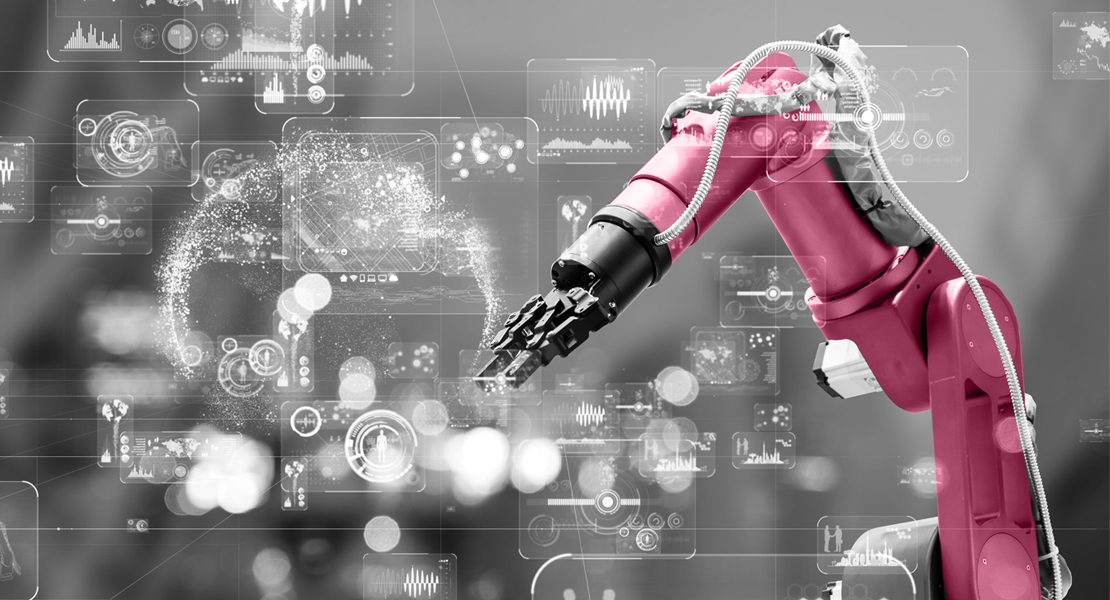When ask who was the biggest driver of innovation in your company last year, do you answer "Corona"? You are not alone in this! There is no denying that the pandemic has moved manufacturing companies in particular to accelerate digitalisation. We take this as an opportunity to put our in-depth Point of View "Factory of the Future", which was created shortly before Corona, to the test: How has the pandemic also affected our view of the factory of the future? Read here how we have worked with our customers in the automotive and manufacturing industries to combat the symptoms, are currently building up protection measures and are increasing immunity to future threats in the long term.
Act One: Tackling Symptoms
The crisis has made it clear what is important for manufacturing companies: functioning core processes and a high degree of digitalisation. Staff absences due to illness or quarantine obligations as well as the introduction of alternating models in shift operations only did not have a serious impact if factory processes were already automated and / or digitalised to a high degree. This was the only way to ensure that traditional value chains could continue to function and production targets could be met. Market advantages could be achieved in particular by those who had a high degree of flexibility in production and could quickly adapt machines and processes to new framework conditions. This changeability and the associated economic success, especially of companies from the Asian region, made many European manufacturing companies realise how important these characteristics are.
After the initial shock and ensuring stability in production, attention then turned to modern technologies and innovations. Augmented and virtual reality applications, for example, were brought out of the prototype stage and into production, for example to maintain or repair a large number of machines by means of remote maintenance. The circumstances left hardly any alternatives for action. Suddenly, many things that had previously been considered "unthinkable" worked digitally or remotely. Many companies realised that they could be more courageous in dealing with innovations - even if one or the other stumbling block lurked at the beginning and mistakes happened.
"With unprecedented speed, digitalisation measures have been implemented to stabilise core value-added processes and maintain competitiveness."
However, the use of new, innovative technologies also placed increased demands on networks and applications. Infrastructure modernisation received a much stronger push than we had expected in last year's Point of View. In particular, the 5G network expansion picked up speed in order to be able to realise latency and data volume requirements.
However, the high acceleration of digitalisation in the factory further exacerbates the shortage of skilled workers in Germany. While a hiring freeze was initially observed in many companies as a result of the pandemic, the initial shock quickly grew into a need to further expand skills for IT and digitisation - while at the same time the supply of suitable skilled workers on the market was manageable. With the increasing degree of digitalisation in production, the required know-how of employees in dealing with digital technologies is also increasing, but not only on the pot floor, but also on the shop floor. The sooner companies become aware of this skills gap in digitised production and become active on the labour market, the higher the chances of building up the corresponding competences.
Second Act: Protect against contagion
After the initial shock and short-term measures to contain the pandemic, the population learned to protect itself. The AHA formula and phrases like "stay at home" were preached as simple and effective preventive measures. But what does "stay at home" mean for internationally operating manufacturing companies?
The progression of the global pandemic gradually affected countries, borders and companies operating across them all over the world. Within a very short time, supply chains that had previously withstood even geo-political tremors collapsed. Is globalisation now being followed by a complete reversal? Re-shoring is seen by many companies as a possible protective measure for the supply chain. We conclude:
"A truly crisis-proof supply chain is now characterised not only by diversification but increasingly by localisation."
Detecon's manufacturing clients are often traditional companies with roots in Europe that have grown strongly with international sales markets, production and suppliers. Re-shoring in the sense of centralisation can hardly be an option for economic reasons. Rather, the aim must be to bring the central elements of the supply chain closer to the sales markets and to establish a networked value creation system. The establishment of such local and self-contained ecosystems can thus spread the risk if individual economic areas are disrupted during a pandemic due to, for example, limited transport capacities, supply bottlenecks and production stoppages.
Of course, such measures are not to be understood as an immediate guarantee of protection, but rather as long-term prevention. We have identified the following questions that manufacturing companies need to address as they work through the pandemic:
- What are our most strategic customers and on which of our products do they depend?
- What are the critical materials and components to be able to produce those same strategic products?
- How well do we know our supply chains and ecosystems around our production sites?
- Can we analyse different scenarios to identify potential risks in our supply chains?
Based on joint assessments with our customers, we do not expect an industry-wide re-localisation of manufacturing. However, the heightened risk awareness indicates that especially the strengthening of local ecosystems is understood as a possible pandemic and, moreover, global crisis protection.
Third act: boosting immunity
Finally, another question arises: How can manufacturing companies protect themselves to successfully cope with similar crises in the future, to minimise the risk of abrupt shortages in demand, supply and labour? For us humans, the answer is clear: vaccinate, vaccinate, vaccinate! It's just a pity that a manufacturing company cannot be so easily "vaccinated" and thus immunised in the long term. So how can a manufacturing company strengthen its immune system against pandemics?
Discussions with our customers suggest the following:
"A stronger focus on innovation is the solution to becoming more resilient to pandemics, which is not only about optimising existing business, but also about developing new business through the use of digital technologies."
Three innovation potentials in particular are proving to be especially important:
- The expansion of the existing, often hardware-based product portfolio with digital value-added services and additional services. On the one hand, this increases the attractiveness and performance of traditional products, such as by bundling products with services, and on the other hand generates new and recurring revenue streams. In this way, a manufacturing company can ensure that in the event of future bottlenecks in production, another revenue pillar - services - is maintained. For example, the telecommunications industry came through the pandemic almost completely unscathed; business with digital services even increased!
- The realisation of digital marketing and sales models. They enable largely contactless but closely networked interaction with customers and partners. In particular, "eCommerce" strategies for marketing the product portfolio and "connected-customer" models for close cooperation with existing customers are coming to the fore. As a result, they are also influencing manufacturing processes, for example by increasing the degree of individualisation of products through modular product kits. It is even possible to change product configurations during the production process. It is crucial to establish the right operating models to enable these new marketing and sales strategies.
- Positioning within platform ecosystems. The ongoing digitisation of the value chain and disappearing industry boundaries are accelerating the growth and importance of platform ecosystems. Often, each company wants to establish its own platform for its products and solutions and not subordinate itself to an existing platform of another provider. The consequence of this is that there is a growing number of platforms from a wide variety of providers that need to be supplied with products and services, but also marketed to customers. In order to position one's own platform in such an ecosystem, the right success factors for the company must be identified and realised, including in production. Here it is important to clarify which partners and which standards one wants to deal with in the future.
Although the innovation potentials mentioned are not entirely new, we rate their strategic importance and business criticality higher than ever before in view of the new and exceptional market conditions.
So what did we learn? In our last article on the "factory of the future", we highlighted Brexit and ongoing trade conflicts between China and the US as risks and drivers of change. COVID-19 has shown us that the trends described on "human-machine interface", "decoupled value chains" and "novel services" now need to be answered even more consistently, quickly and radically. Our discussions with customers show that manufacturing companies in DACH have also implemented this successfully. Now, however, it is important to maintain the speed of transformation, the high degree of innovativeness and the courage to make investments in order to continue to play in the top league internationally.
With Detecon, T-Systems and Deutsche Telekom, we offer a partner network whose range of services can provide decisive answers to strategic challenges, also in the wake of the global pandemic. We accompany our clients from the definition of business models and their adjustments in the course of digitalisation, to the architecture of data and infrastructure, to connectivity management, in order to be prepared for future crises.






